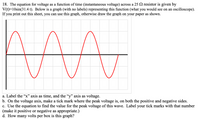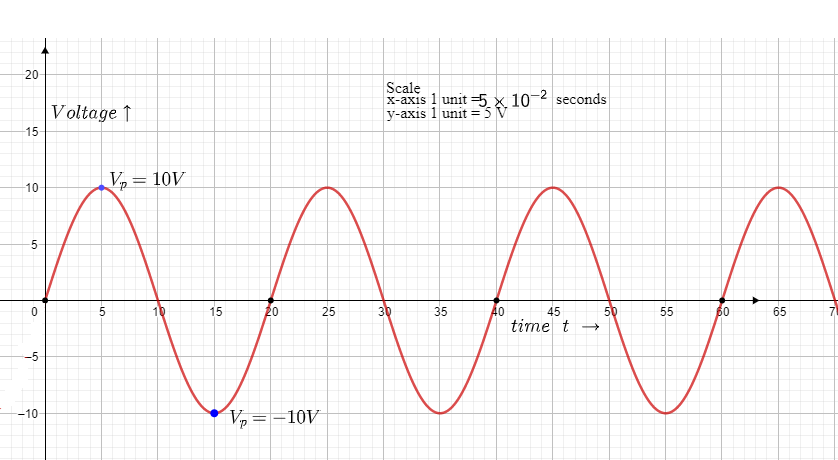Question
Need help with e through j please

Transcribed Image Text:18. The equation for voltage as a function of time (instantaneous voltage) across a 25 2 resistor is given by
V(t)=10sin(31.4 t). Below is a graph (with no labels) representing this function (what you would see on an oscilloscope).
If you print out this sheet, you can use this graph, otherwise draw the graph on your paper as shown.
a. Label the “x" axis as time, and the “y" axis as voltage.
b. On the voltage axis, make a tick mark where the peak voltage is, on both the positive and negative sides.
c. Use the equation to find the value for the peak voltage of this wave. Label your tick marks with that number
(make it positive or negative as appropriate.)
d. How many volts per box is this graph?
![e. On the time axis, make a tick mark at the end of every period shown (starting the first period at t=0).
f. Use the equation to calculate the frequency (f, not angular frequency @) of this wave. [5 Hz]
g. Calculate the period of this wave. [0.2 s]
h. On the time axis, label each of your tick marks with the appropriate time using your calculated period.
i. How many seconds per box is this graph?
j. What is the rms voltage across the resistor? (what you would measure with a multimeter?) [7.07 V]](https://content.bartleby.com/qna-images/question/266e7f29-ba1d-4acb-9482-ffb76dbeef2e/c1f652b8-7ce5-4180-ab78-e07e9f2edd56/ngbehu_thumbnail.png)
Transcribed Image Text:e. On the time axis, make a tick mark at the end of every period shown (starting the first period at t=0).
f. Use the equation to calculate the frequency (f, not angular frequency @) of this wave. [5 Hz]
g. Calculate the period of this wave. [0.2 s]
h. On the time axis, label each of your tick marks with the appropriate time using your calculated period.
i. How many seconds per box is this graph?
j. What is the rms voltage across the resistor? (what you would measure with a multimeter?) [7.07 V]
Expert Solution
arrow_forward
Step 1
Given:
Instantaneous voltage function
Solution:
Part a, b, c, d, e, h

Step by stepSolved in 3 steps with 1 images

Knowledge Booster
Similar questions
- PRACTICE IT Use the worked example above to help you solve this problem. Find I, 1,, and I, in figure a, where E = 11 V. 11 = 1.92 A 12 =|-2.37 A -.45 13 Your response differs from the correct answer by more than 10%. Double check your calculations. A 4.0 Ω 6.0 N 10 V 2.0 N (a)arrow_forwardFast pls i will give u like for sure solve this question correctly in 5 min plsarrow_forwardWhat must be true about a surface or a portion of a surface in order to be able to associate a single area vector with that surface?arrow_forward
- I NEED HELP WITH PART C PLEASE!!! A bare helium nucleus has two positive charges and a mass of 6.64 ✕ 10−27 kg. (a) Calculate its kinetic energy in joules at 1.20% of the speed of light. ANS: 4.302 x 10^-14 J (b) What is this in electron volts? ANS: 26.853 x 10^4 eV (c) What voltage would be needed to obtain this energy?______ Varrow_forwardneed help on aarrow_forwardAn electrical impulse in one of our brains neurons. Can transmit 11.6 billion lons, each with a charge. of te. How much charge in nC is transmitted? q= nCarrow_forward
- A. Using Amperes Laus Fud B a. What s B when r>R Shou Aour warlk B E bWhat is s when rR Shaw your werls 2. Find TE using Gauss Laus. a. What is E whan rR? Show your wank E= b What is E Shiw your wirk These are cond uctors.arrow_forwardNeed help wtih parts A, B, and C plsarrow_forwardsnaes uopaidwon uopsand Quèstion 1 a) Find the magnitude of q1 with respect to q2. b) Mention the signs of the charges q1 & q2. 92 A Moving to another question will save this response.arrow_forward
arrow_back_ios
SEE MORE QUESTIONS
arrow_forward_ios